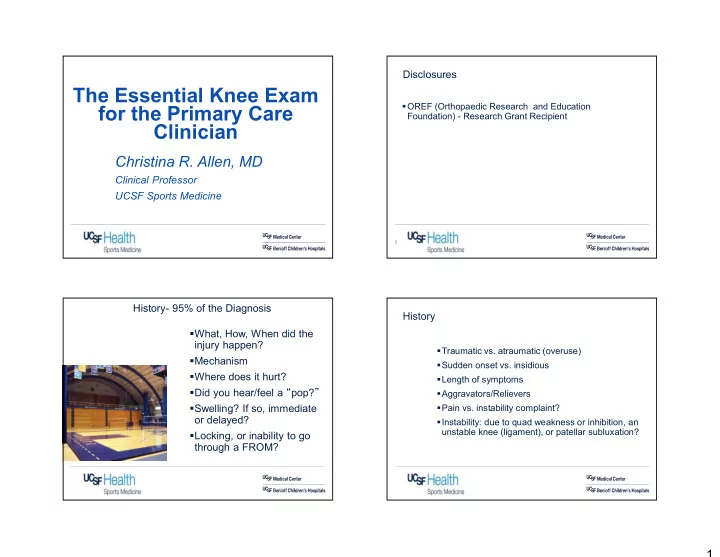

Disclosures The Essential Knee Exam OREF (Orthopaedic Research and Education for the Primary Care Foundation) - Research Grant Recipient Clinician Christina R. Allen, MD Clinical Professor UCSF Sports Medicine 2 History- 95% of the Diagnosis History What, How, When did the injury happen? Traumatic vs. atraumatic (overuse) Mechanism Sudden onset vs. insidious Where does it hurt? Length of symptoms Did you hear/feel a “ pop? ” Aggravators/Relievers Swelling? If so, immediate Pain vs. instability complaint? or delayed? Instability: due to quad weakness or inhibition, an unstable knee (ligament), or patellar subluxation? Locking, or inability to go through a FROM? 1
Knee Physical Exam-General RED FLAGS- Don ’ t Miss these… Night pain Standing Evaluation Fever Supine Weight Loss Sitting Limp • THINK ABOUT INFECTION OR TUMOR!!! Modify Exam for Acute Injury Always check the hip and back Always examine both knees- Normal vs Abnormal Physical Examination- Standing Squat Test Always examine both knees • Gait • alignment (Varus, Valgus) • obesity, LLD, atrophy • torsional deformities (tibial) • feet (pronation) • Squat ability, pain with squat (where)?- Patellofemoral or Meniscus based on location • Thessaly ’ s Test- Meniscus • Single Leg Squat (core strength) 8 2
Thessaly Test THESSALY TEST Sensitivity of 90.3% Specificity of 97.7% Physical Examination- Supine Single leg Squat Test Supine position: Always examine both knees Effusion (15 cc->quad inhibition) Quadriceps Atrophy Range of Motion Palpate soft tissues Joint Line Tenderness McMurray ’ s test (Meniscus) Ligament Exam • ACL, PCL, MCL, Posterolateral Corner 11 12/15 /2018 3
JOINT LINE TENDERNESS Palpation of the anterior, middle, and posterior parts of both the medial and lateral joint spaces. SENSITIVITY SPECIFICITY 85% 30% Fowler and Lubliner, 1989 MCMURRAY ’ S TEST Knee is flexed and placed in MCMURRAY ’ S external rotation TEST Examiner applies a valgus or varus force Knee is then extended. (+) = Pain and/or a popping/ McMurray TP: The Semilunar snapping sensation. Cartilages. SENSITIVITY SPECIFICITY Br J Surg 29: 407-414, 1942 29% 96% Fowler and Lubliner, 1989 4
McMurray ’ s Test McMurray ’ s Test ANTERIOR DRAWER TEST ACL Injury Add nml and inj MRI Hip flexed at 45 ° , knee flexed at 90 ° With both thumbs placed on the joint line, the tibia is gently drawn forward. Excursion of the tibia is compared with the unaffected side. SENSITIVITY SPECIFICITY 41% 95% Katz and Fingeroth, 1986 5
LACHMAN ’ S TEST ANTERIOR DRAWER TEST 15 ° - 30 ° of knee flexion The femur is stabilized with one hand and the tibia is gently drawn forward with the opposite hand. (+) = Anterior translation of the tibia with a “ soft ” or “ mushy ” endpoint BEST TEST FOR ACL INJURY SENSITIVITY SPECIFICITY 82% 97% Katz and Fingeroth,1986 LACHMAN ’ S TEST LACHMAN’S TEST 6
PIVOT SHIFT TEST DROP LACHMAN ’ S TEST Tibia is internally rotated and axially loaded while applying a gentle valgus stress to the knee. Start at full extension. Knee is then slowly brought into flexion. (+) = “ Shift ” felt with subluxation/ reduction of the lateral tibial plateau anteriorly as the knee is brought into further flexion at ~30 ° SENSITIVITY SPECIFICITY 81% 98% Katz and Fingeroth, 1986 PIVOT SHIFT TEST PIVOT SHIFT TEST Galway RD, Beaupre A, MacIntosh DL: Pivot Shift: A Clinical Sign of Symptomatic ACL Insufficiency J Bone Joint Surg [Br] 54: 763-764, 1972 7
POSTERIOR SAG SIGN PCL Injury Knee is placed in a resting position at 90 degrees flexion (+) = “ Sag ” posteriorly Compare with the opposite side. POSTERIOR DRAWER TEST Hip flexed at 45 ° , knee flexed at 90 ° With both thumbs placed on the joint line, the tibia is gently pushed posteriorly. Excursion of the tibia is compared with the unaffected side. 8
PCL INJURY LCL Injury VARUS STRESS TESTS A Varus stress is applied both in full extension and in 20-30 ° of flexion Test in extension checks for injury of posterolateral corner structures (may see some laxity with isolated LCL injury) Test in flexion evaluates LCL Grading of Injury based on Jt. Space opening: Grade I: 0 to 5 mm Grade II: 6 to 10 mm Grade III: 11 to 15 mm 9
VARUS STRESS TEST-LCL INSTABILITY VARUS STRESS TEST PLRI- Dial test PLRI- Dial test Patient may be tested supine or prone Side to side difference > 15 ° abnormal Test at 30 and 90 degrees of flexion External rotation at 30 ° : Isolated PLS injury External rotation at 30 ° , 90 ° : PLS+PCL injury 10
VALGUS STRESS TESTS MCL Injury A Valgus stress is applied both in full extension and in 20-30 ° of flexion Test in extension checks for injury of posteromedial corner structures (capsule, semimembranosus connections) Test in flexion evaluates MCL Grading of Injury based on Joint Space opening: Grade I: 0 to 5 mm Grade II: 6 to 10 mm Grade III: 11 to 15 mm MCL Instability VALGUS STRESS TEST 11
Additional Physical Examination tests-Supine Patellar Apprehension Sign Patella Mobility/glide (quadrant system) Patella Tilt (retinaculum tightness) Apprehension Test (instability) Clarke ’ s sign (PF pain) Patella Facet and condyle tenderness Symmetric strength/flexibility of quads, hamstrings, gastroc/soleus, ITB, hip flexors, hip Ext Rotators Hip ROM Q- angle Lateral Position: Ober ’ s test- IT band Physical Examination-Sitting Modified Lachman ’ s Test (ACL) PF instability Tests • 90 ° /seated “ Q ” angle ‒ avg. nl = 4.3 ° • “ J ” tracking with extension • ligamentous laxity ‒ elbows, knees, thumb-forearm ‒ 2 nd MCP joint, shoulders Ligament Exams • ACL- Modified Lachman Test • Also can check LCL/MCL 12
Recommend
More recommend